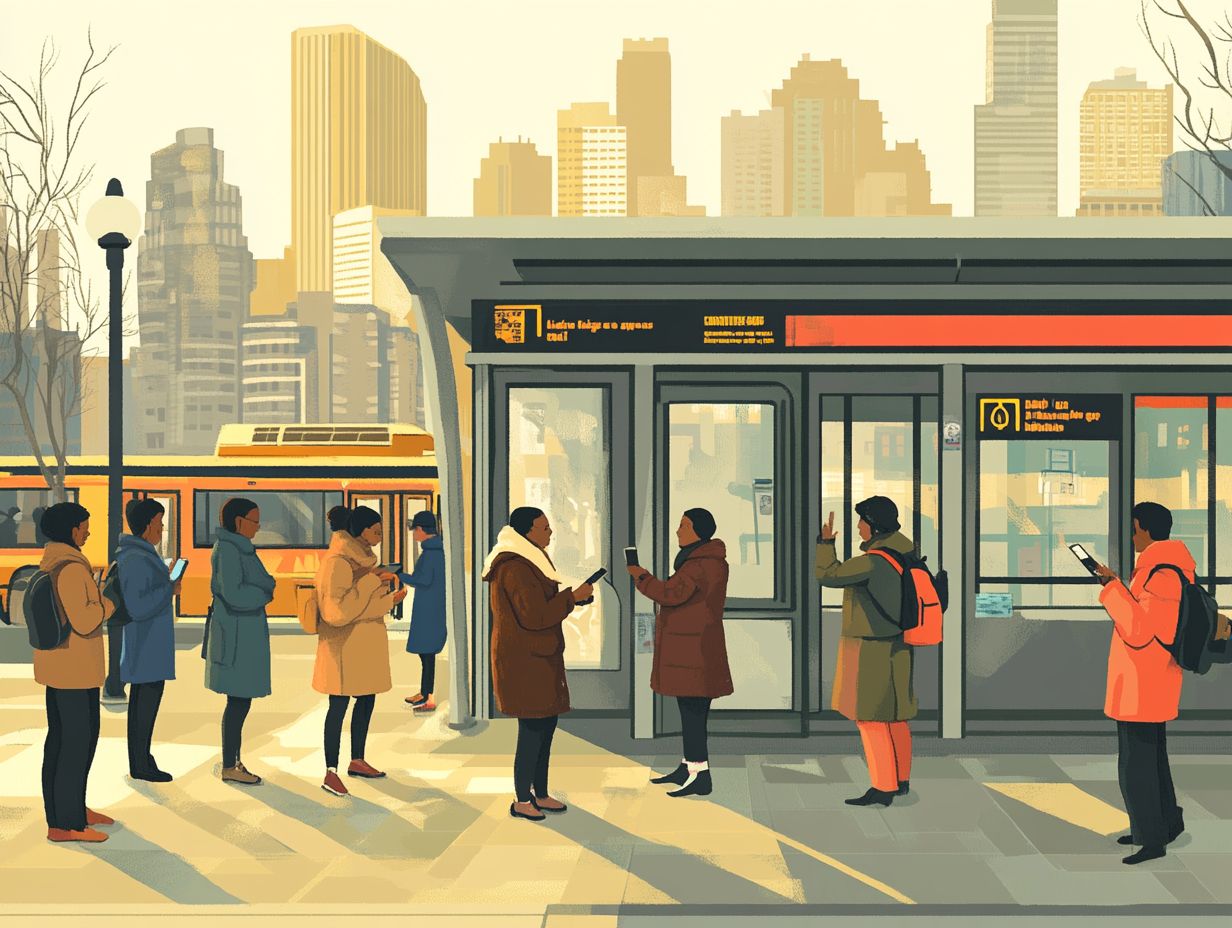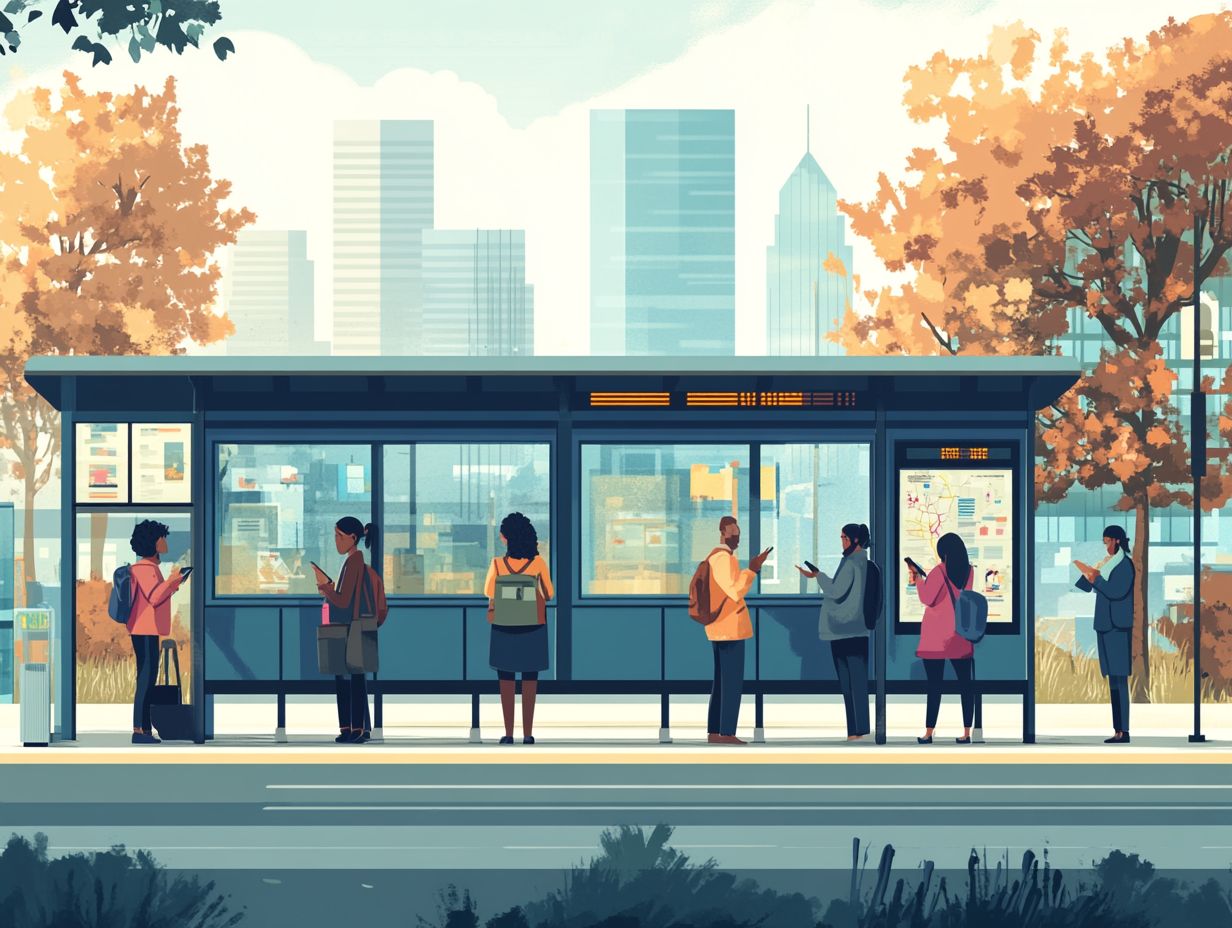Understanding Coverage for Public Transportation
Public transportation is essential in shaping urban mobility, connecting communities, and enhancing your overall quality of life. Join us as we explore the vital role of public transportation in transforming your community!
This article delves into the various modes of public transportation, showcasing their unique features and the factors that influence coverage, such as geographic location and population density. It highlights the advantages of well-structured public transit systems, including their environmental and economic benefits.
It also addresses the challenges in achieving adequate coverage, from funding limitations to equity concerns.
Contents
- Key Takeaways:
- Types of Public Transportation
- Factors Affecting Coverage
- Benefits of Adequate Public Transportation Coverage
- Challenges to Coverage
- Equity and Accessibility Concerns
- Frequently Asked Questions
- What is public transportation coverage?
- Why is understanding coverage for public transportation important?
- What factors determine coverage for public transportation?
- What types of services are included in public transportation coverage?
- Can anyone use public transportation services?
- How can I find out more about the coverage for public transportation in my area?
Key Takeaways:

- Public transportation includes buses, trains, and subways, all designed to serve you.
- Your access to public transportation is shaped by geography, budgets, and population density.
- Adequate coverage of public transportation has many benefits, including improved accessibility and mobility, as well as positive impacts on the environment and economy.
Defining Public Transportation and Coverage
Public transportation is a vital system designed for your convenience. It offers a range of transport services that connect urban and rural areas seamlessly. It includes buses, subways, and trains, catering to millions of travelers every day.
To ensure that these systems run smoothly, adequate coverage insurance is essential. This financial protection safeguards against risks like road accidents. It allows both public entities and transit authorities to maintain operational stability and ensure community safety, particularly in challenging times, such as crises like COVID-19.
Insurance coverage for public transportation is crucial for protecting these essential networks. Liability insurance acts as a shield against claims stemming from accidents or injuries involving passengers, ensuring that funds are available for necessary medical expenses. For more detailed insights, consider understanding coverage for transportation companies; collision coverage specifically protects transit vehicles from damage in accidents, while comprehensive coverage addresses non-collision-related incidents, including vandalism or natural disasters.
Major providers like Travelers and John M. Glover Insurance Agency offer tailored policies to meet diverse transit needs and provide valuable advice on maintaining safety standards. With the backing of transit authorities overseeing these operations, effective insurance coverage fosters public trust and contributes significantly to the sustainability of public transport networks.
Types of Public Transportation
Public transportation encompasses a variety of types, each tailored to meet the unique needs of communities and their transit authorities. You ll find major categories such as:
- bus services
- light rail
- heavy rail
- ferries
- paratransit options
All of these collaborate to create a complex network that serves urban, suburban, and rural populations alike.
Overview of Different Modes of Transportation
Different modes of public transportation are essential to the overall transit ecosystem, each playing a crucial role in addressing your community’s mobility needs. Buses offer flexible routes that adapt to demand. Subways deliver rapid transit in urban environments. Trains connect cities over longer distances, and ferries cater to waterfront communities, all contributing to a well-rounded transportation network.
Each mode has its own distinct advantages and challenges. Buses can easily adjust their routes based on demand, but they can encounter delays due to traffic congestion. Subways excel at providing quick and reliable service over short distances, though they require significant money spent on building and maintaining transit systems. Trains are efficient for longer journeys, but they often come with higher operational costs and limited routes. Ferries offer a scenic travel experience and are vital for coastal access, yet they can be at the mercy of weather conditions.
Together, these varied systems, with millions of daily commuters relying on them, create an integrated public transportation framework that enhances accessibility and helps lower overall transportation costs.
Factors Affecting Coverage
The coverage of public transportation systems depends on a variety of factors. These include the types of insurance for accidents and injuries, transportation budgets, and local policies. For those involved in ride-sharing, understanding coverage for ride-sharing vehicles is essential, as each of these elements can greatly influence the full insurance that a system requires.
Grasping these factors is essential for securing adequate financial protection against potential risks. Understanding this landscape enables you to navigate the complexities of insurance and ensure that your systems are well-protected.
Geographic Location and Population Density

Geographic location and population density significantly shape the public transportation services you rely on. They also affect the insurance requirements that accompany them. In areas with high population density, you can expect more frequent services and larger capacity vehicles.
This naturally leads to increased potential liabilities and insurance costs. In contrast, rural regions often depend on smaller, less frequent transit options like vans or shuttles. This can result in lower insurance premiums due to reduced passenger capacity and less congested routes.
For example, a bustling urban center would require extensive coverage for buses navigating crowded streets. Meanwhile, a rural community might focus on basic liability coverage for its limited transport options.
Unique geographic features, such as mountainous terrains or coastal areas, can further complicate your insurance needs. Specific policies may be necessary to address the risks associated with harsher environmental conditions. Ultimately, understanding these influences allows you to tailor both your transportation solutions and the necessary protections to fit each unique setting.
Transportation Budgets and Policies
Transportation budgets and policies are crucial in shaping the level of service and insurance coverage within public transportation systems. When funding is adequate, transit authorities can maintain their vehicles, hire skilled staff, and secure essential insurance for accidents and injuries along with full insurance against unexpected disruptions.
When local and federal funding sources come together, they can significantly enhance the efficiency and reliability of public transportation services. This allows communities to flourish. However, budget constraints often stand in the way of these improvements, compelling authorities to make difficult decisions that can compromise both service quality and coverage areas.
Limited financial resources can lead to reduced service frequency, longer wait times, and even route discontinuations. This disproportionately impacts those who rely on public transport for their daily commutes. Inadequate funding hampers operational capabilities and creates a ripple effect that discourages ridership, ultimately undermining the overall viability of the system.
Benefits of Adequate Public Transportation Coverage
Adequate public transportation coverage insurance offers a wealth of benefits. These range from bolstering community safety to providing financial protection against road accidents. By ensuring that transit authorities are properly insured, you contribute to the seamless operation of these vital systems.
Safeguarding both the public and their assets with confidence is essential. Don’t wait until it’s too late make sure your public transport system is covered today!
Impact on Accessibility and Mobility
The influence of comprehensive public transportation coverage on accessibility and mobility is profound. It ensures that every community member, including those in vulnerable populations, can access essential services and opportunities.
Enhanced coverage cultivates a reliable transportation network that fosters inclusivity and promotes community safety. Cities that implement comprehensive transit plans often witness remarkable improvements in employment rates among low-income residents who previously faced challenges reaching job sites.
Programs like the Americans with Disabilities Act (ADA) have driven transit systems to adopt accessible features, such as ramps and specialized services for individuals with mobility challenges. Policies that subsidize fares for seniors and individuals with disabilities encourage wider usage.
These initiatives boost individual well-being and revitalize urban areas areas that need to be navigable for everyone!
Environmental and Economic Benefits
Public transportation presents substantial environmental and economic advantages, effectively promoting lower emissions and alleviating traffic congestion. When transit systems have adequate and comprehensive coverage, they can invest in sustainable practices.
By embracing a well-structured transit system, communities contribute to reduced air pollution while unlocking new economic opportunities. Lowering transportation costs for commuters makes the workforce more accessible, allowing individuals to pursue employment or education without the burden of exorbitant travel expenses.
As transit systems expand, they create a multitude of jobs, spanning from infrastructure development to maintenance and operations. This interconnectedness highlights the importance of comprehensive coverage; when public transit reaches more areas, it catalyzes sustainable practices and fosters a thriving economy.
Ultimately, this ensures a cleaner planet for generations to come.
Challenges to Coverage

Challenges to coverage in public transportation arise from a multitude of sources, including funding constraints, problems with roads and bus stops, and the intricate issues public risk managers encounter in navigating the insurance landscape.
These obstacles can significantly undermine the effectiveness of coverage insurance and put the reliability of transit services at risk.
Funding and Infrastructure Limitations
Funding and infrastructure limitations present significant challenges to public transportation systems. These constraints restrict transit authorities from making essential improvements and maintaining operational efficiency.
In cities like Detroit and Baltimore, budget cuts have led to service reductions that disproportionately affect low-income communities. Inadequate funding translates directly to fewer buses on the road and longer wait times, creating frustration for commuters and raising legitimate safety concerns.
The struggle to secure sufficient coverage insurance means that the fallout from accidents or disruptions can escalate, placing an additional strain on public safety resources. Without adequate investment, vulnerable populations find themselves without reliable transit options, further exacerbating social inequalities.
Consider how important it is to advocate for better public transportation. Let s work together to create a future where everyone has access to reliable transit options!
Equity and Accessibility Concerns
Equity and accessibility concerns sit at the heart of effective public transportation systems. Differences in service can create big barriers to mobility for underprivileged populations. Addressing these issues is crucial to ensure that coverage meets the diverse needs of the community.
This challenge is especially evident in urban areas. Low-income communities often struggle with limited access to reliable transportation options. This lack of access can severely hinder their ability to reach jobs, schools, and essential services.
Local transportation authorities need to recognize these inequities and craft tailored solutions that respond to the unique needs of various neighborhoods. For example, introducing mobile apps that provide real-time transit information and enhancing services like paratransit, a service that provides transportation for those with disabilities, can effectively bridge these gaps.
Cities like Los Angeles have taken significant steps by implementing dedicated bus lanes in underserved areas. These bold initiatives show how crucial transportation solutions can transform lives, improving transit speed and reliability. They highlight the vital role of equitable transportation in promoting inclusivity and enhancing the well-being of the entire community.
Frequently Asked Questions
Curious about public transportation? Here are some common questions answered to help you navigate your travel options!
What is public transportation coverage?
Public transportation coverage refers to the range and extent of services provided by transportation agencies to the public. It includes services such as buses, trains, and subways that enable people to travel from one place to another.
Why is understanding coverage for public transportation important?

Understanding coverage for public transportation is important as it shows you what services are available and how to utilize them effectively. For more detailed information, refer to understanding coverage for transportation services. It also helps you plan your travel and make informed decisions about which mode of transportation to use.
What factors determine coverage for public transportation?
The coverage of public transportation is determined by factors such as population density, geographical location, and funding. Areas with a higher population and urban density tend to have more extensive coverage compared to rural areas.
What types of services are included in public transportation coverage?
Public transportation coverage can include various services such as buses, subways, light rail, commuter trains, and paratransit for individuals with disabilities. Some areas may also have ridesharing options like carpooling or vanpooling.
Can anyone use public transportation services?
Yes, public transportation services are available to everyone within the coverage area. However, some services may have certain eligibility requirements or restrictions, such as age or disability, so it is important to check with the specific transportation agency.
How can I find out more about the coverage for public transportation in my area?
You can find out more about the coverage for public transportation in your area by contacting your local transportation agency or visiting their website. They should have information on routes, schedules, and fares, as well as any updates or changes to their services. Visit your local transportation agency s website today to discover the routes and services available to you!





